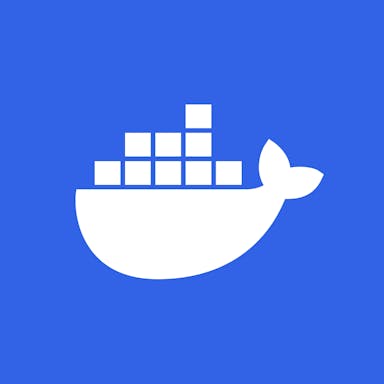Thesis
Application programming interfaces (API) are the building blocks of software that link apps and organization ecosystems together. By integrating new applications with existing software systems, APIs enable developers to create more modular components and take advantage of existing web apps, which increases development speed. Furthermore, APIs simplify the integration and management of existing platforms. From integrating maps into ride-sharing apps to enabling customer service communication in e-commerce platforms, APIs power the interconnectedness of technology people use every day. By the end of 2022, there were over 26 million developers globally, over 90% of which use APIs to some extent. The reliance on APIs has only continued to grow. As of April 2023, 98% of developers view APIs as a key contributor to their work, and 95% want heavier investment in APIs within the next year.
With the increasing reliance on APIs, the world is shifting towards an API-first development model where the design of an application starts with an API in mind. This is the opposite of the traditional code-first approach, where APIs are often inserted into an application’s code in the final stages of development. An API-first strategy is common for microservices architectures, as it ensures application ecosystems start as modular and reusable tools to build off of. However, building and managing APIs can be time-consuming and inefficient. In 2020, 55% of developers considered most API documentation to be “below average or worse.” API work occurs across desktops and servers spread across the enterprise and the cloud. Large enterprises (>10K employees) can have over 25K APIs in use, which makes finding APIs, artifacts, and other resources challenging.
That’s where Postman comes in. Postman was founded to simplify the API testing process and has expanded to address every stage of the API life cycle, from planning and design to implementation and testing to deployment and versioning. At the end of 2023, Postman claimed to host the largest public collections of APIs on the internet. Used by millions of developers every month to manage their API development, Postman allows developers to make various types of HTTP requests, save environments for later use, and convert the API to code for various languages.
Founding Story

Source: Postman
Postman was co-founded in 2014 by CEO Abhinav Asthana, repeat tech founder with Postman’s CPO Abhijit Kane, along with CTO Ankit Sobti, who was formerly a software engineer at Adobe. From an early age, Asthana demonstrated his passion for technology when he received his first computer — a Pentium I PC. Upon immersing himself in the world of coding, he became proficient He recalls that by eighth grade, he was able to build an entire web application. Breakthroughs in cloud computing in 2006, around the time he was graduating high school, meant that more and more people began accessing software, computer power, and files over the web instead of on their desktops. This was the ideal backdrop for an avid web application builder like Asthana.
During his college years at BITS Pilani, Asthana launched a start-up with a few friends, including future co-founder Abhijit Kane. The startup, initially coined BITS360, was a viewer that scrolled through high-resolution, 360-degree panoramic views (this was before Google Street View existed). The team built a set of systems and APIs that would allow people to effectively map the world around them. They raised $400K in seed funding and named the company TeliportMe.
In 2012, Asthana spent time interning at Yahoo! in Bangalore, where he met Sobti. Together, their job was to take APIs and convert them into a shareable format that developers could use in their projects. Along the way, Asthana and Sobti kept running into the same problems. At the time no tools existed to help them implement and debug their APIs. To make matters worse, whenever an API was updated, the team would have to start all over again.
After exiting TeliportMe, Asthana started consulting on design and development for a set of projects. To his frustration, he continued to run into the same problems with testing and debugging APIs that he had encountered at Yahoo! and TeliportMe. He searched for an existing solution but could not find anything to match his needs. After spending a weekend building a basic HTTP client for Chrome, Asthana ultimately wrote an early version of Postman as an open-source tool and put it up on the Chrome Web Store. When a user on Stack Overflow asked for help with APIs, Abhinav replied with the link to Postman. The tool went viral, seeing over 2K downloads in a matter of days.
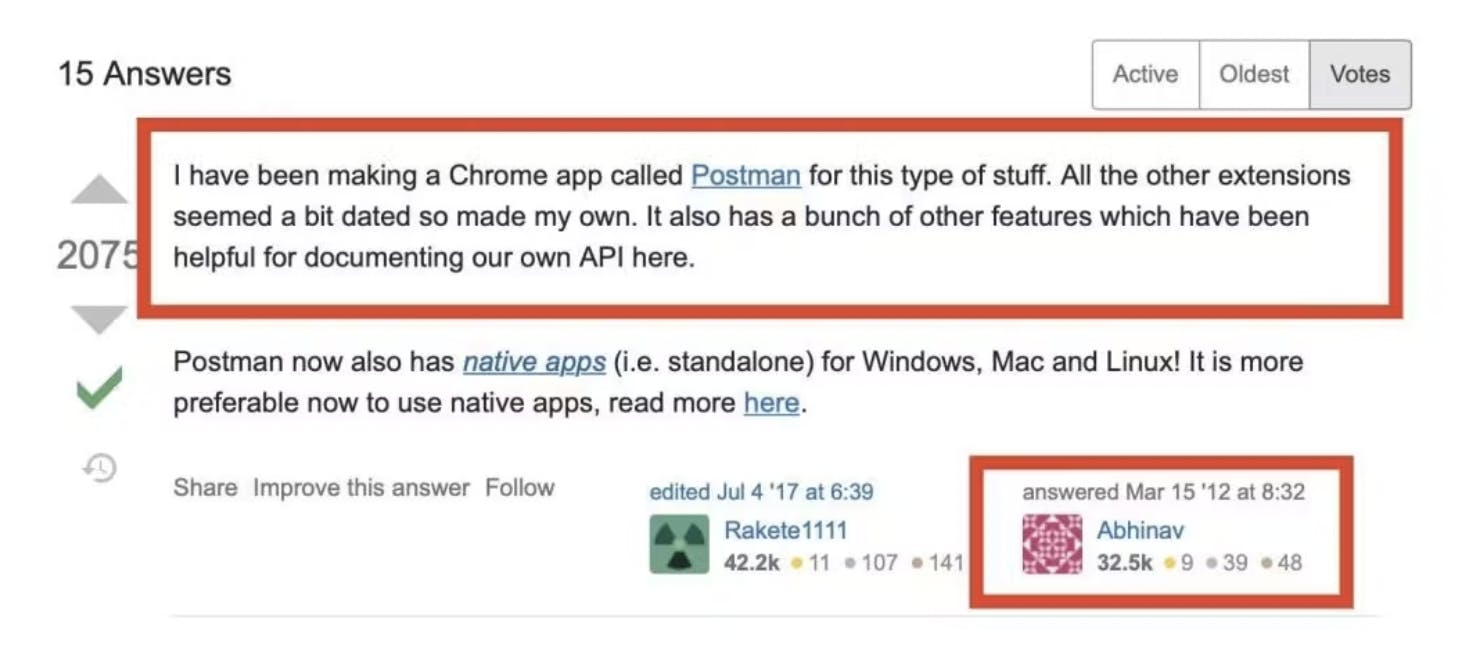
Source: Stack Overflow
At the time, Asthana got an invite from the Chrome team in the Bay area to feature Postman as one of the top apps on the new Chrome app platform. They needed a new version of Postman because they were trying to position it as a competitor to native apps. Asthana decided to rewrite Postman and build it further. As the app's usage grew, he recruited Kane and Sobti to help build Postman. In 2014, the trio launched the startup formally.
Product
API Repository
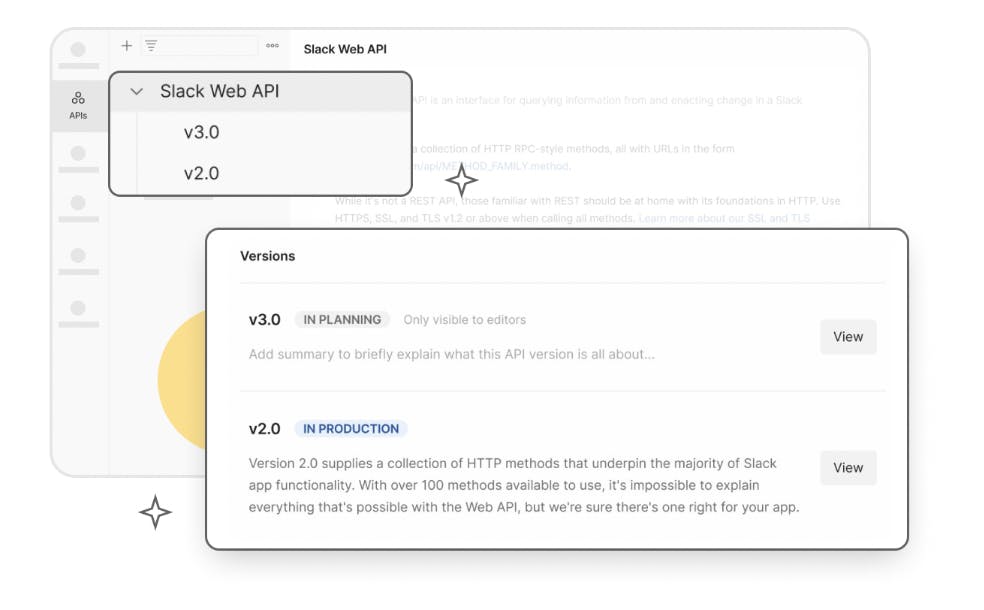
Source: Postman
Postman's API repository is a cloud-based, version-controlled, centralized repository for all API artifacts throughout the API lifecycle. It enables teams and organizations to gather metrics and discern insights through the built-in governance capabilities on the platform. Postman's desktop and web applications connect to the API repository through workspaces for personal, team, partner, or public use. With the Postman API repository, users can simplify, organize, and scale their entire API lifecycle, whether it's for a single API or for their entire API landscape.
The API builder, another Postman feature, helps users easily implement an API design workflow through specifications like OpenAPI, GraphQL, or RAML. Elements created in Postman can be pushed to a user's GitLab repository, where the schema and collections can coexist alongside the source. Developers can access API assets in a local development folder, allowing for easy integration with local tools during design, development, and testing.
The Private API Network provides optimal visibility into APIs for teams or organizations. It offers versioning capabilities, allowing control and management of multiple API versions within the network. APIs can be organized into hierarchical folders to align with organizational needs. Postman claims its Public API Network is the largest public API hub, enabling easy sharing of public APIs. Organizations can showcase their APIs through public workspaces, while developers can discover thousands of public APIs from renowned companies.
API Tools
Postman provides a comprehensive set of API tools that support the entire API lifecycle, from design to testing, documentation, mocking, and sharing APIs. The Postman API client is the foundational tool of Postman, and it enables users to easily explore, debug, and test APIs while also enabling them to define complex API requests for HTTP, REST, SOAP, GraphQL, and WebSockets. Through the API client, users can organize requests into Postman Collections to help them organize their requests for reuse. Collections can also contain JavaScript code to tie requests together or automate common workflows, and users can use scripting to visualize API responses as charts and graphs.
Postman allows API specifications to be designed using OpenAPI, RAML, GraphQL, or SOAP formats. The schema editor facilitates working with specifications of any size, offering validation through a built-in linting engine. Postman Collections can be generated from specifications, enabling synchronization across different stages of the API lifecycle. Additionally, Postman offers a lot of advanced features like API development, setting up mock endpoints for APIs that are still under development, API documentation, assertions for the responses received from API endpoint execution, integration with CI-CD tools like Jenkins, TeamCity, etc., and automating API test execution.
Postman's automatic documentation features allow developers to make documentation an integral part of their API workflow. Markdown-enabled and machine-readable documentation can be generated using the Postman Collection format or OpenAPI files. The documentation includes detailed information on requests and provides sample code in multiple client languages.
Postman facilitates the creation and execution of API tests directly within the platform or as part of CI/CD pipelines using Newman, a Collection Runner for command-line execution. Developers can write functional tests, integration tests, and regression tests, leveraging Postman's Node.js-based runtime and supporting libraries.
Postman's mock server feature allows developers to simulate API endpoints before production deployment. Mock servers can be created in the cloud, enabling the simulation of API behavior in local, testing, or staging environments. Custom delays for responses can be specified to mimic network latency.
Workspaces

Source: Postman
Postman's workspaces enable users to organize their Postman work and collaborate with teammates. Workspaces group together various elements such as APIs, collections, environments, and monitors. Users can create different types of workspaces, including personal, team, partner, or public workspaces. Personal workspaces are private and only accessible by the user who created them, while team workspaces enable collaboration between team members.
Personal workspaces are designed for individual-focused work and offer synchronization across different Postman instances and versions. Users can restrict access to APIs, collections, and other elements in private workspaces.
Partner workspaces enable external partners to collaborate on building products and services using APIs. These workspaces are shared, secure, and controlled, providing real-time updates and notifications about API changes.
Public workspaces allow for the sharing of APIs with the global community. They are searchable and accessible through the Postman Public API Network, enabling feedback gathering, developer onboarding, and showcasing of API projects.
Team workspaces facilitate collaboration among team members within a shared workspace. Access control and version history features ensure secure and effective collaboration, allowing team members to comment on, use, modify, and fork existing elements.
Integrations
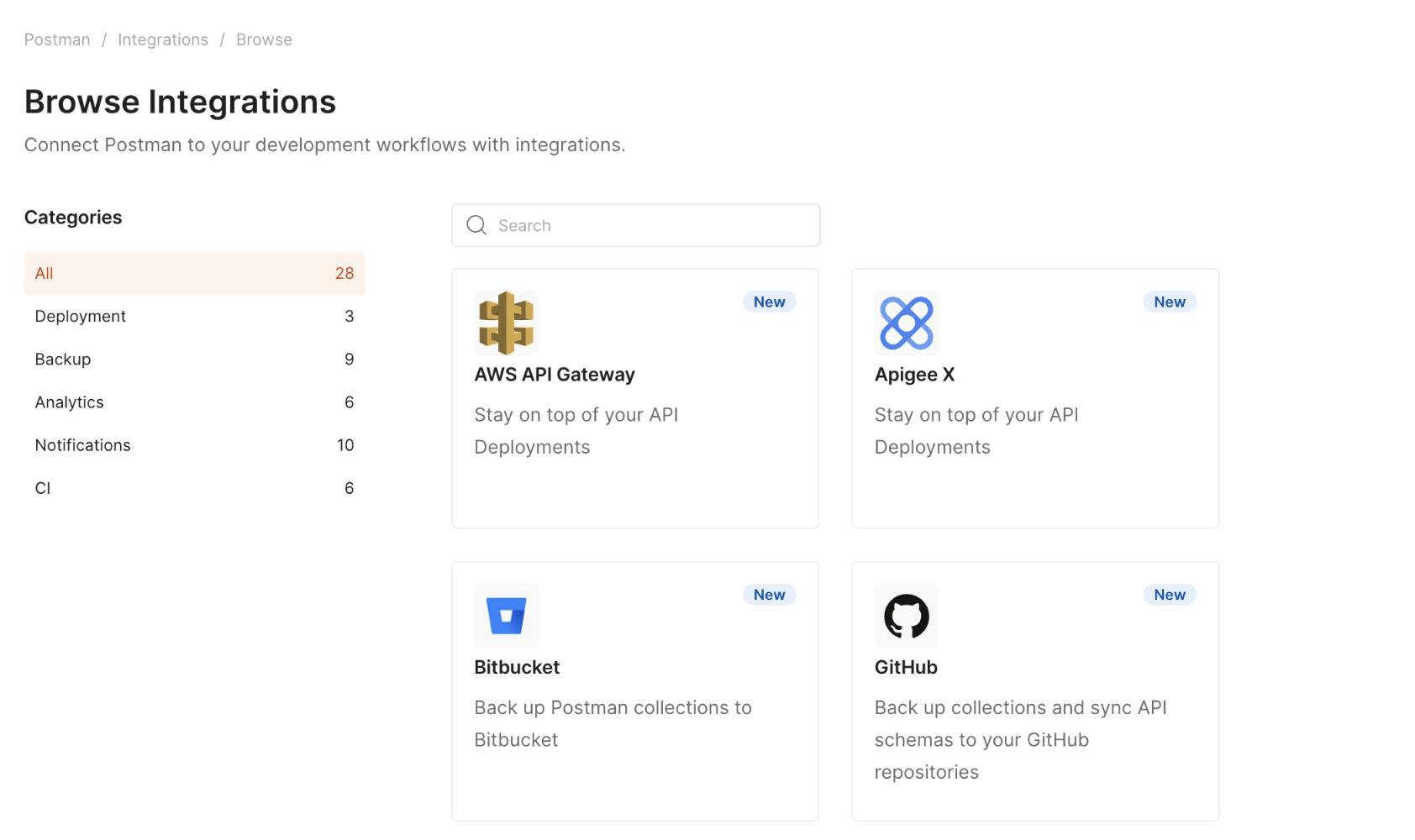
Source: Postman
As of January 2024, Postman has over 30 integrations across development, testing, monitoring, visualization, and documentation, among other categories. These integrations allow users to connect Postman to their API workflows with integrations for popular third-party solutions. It provides native support for various continuous integration and continuous delivery (CI/CD) tools, allowing developers to view build statuses and trigger new builds directly within the platform. Additionally, the Postman API and open-source technologies offer extensibility and customization options for integrating with different development environments. Some examples of pre-built integrations include:
Slack: View your team's activity feed, search shared Postman Collections, and monitor Postman Monitors' results, all within a Slack channel.
APIMatic: Convert Postman API documentation into various formats (Swagger, API Blueprint, RAML) using APIMatic's API transformer tool
GitHub: Backup and synchronize Postman Collections with GitHub, ensuring version control and facilitating collaboration among team members.
Market
Customer
Postman is used by a wide range of organizations from various industries around the world. Some of the notablecustomers of Postman include Atlassian, PayPal, Box, Microsoft, Accenture, and Phillips. As of 2023, Postman claims that it is used by over 500K companies, including 98% of the Fortune 500 companies. 25 million developers use the platform, which in early 2023 represented ~95% of total developers globally.
Postman’s API management system simplifies rapid scaling and software development for smaller customers. As a result, many of its customers are organizations with employee counts under 50. Conversely, larger organizations are more likely to be heavily reliant on internal or partner-facing APIs. In particular, 40% of companies with over 10K employees report having >250 internal APIs. Though predominantly used by smaller customers, in 2023, Postman reported its users’ company sizes to be bimodal around <10 and >1K employees.

Source: Postman
Additionally, according to third-party research, the majority of Postman's customers use Postman for API management most frequently across software development, technology, and machine learning. Nonetheless, Postman’s customer survey shows that the platform is used across a wide range of industries, many outside of tech.
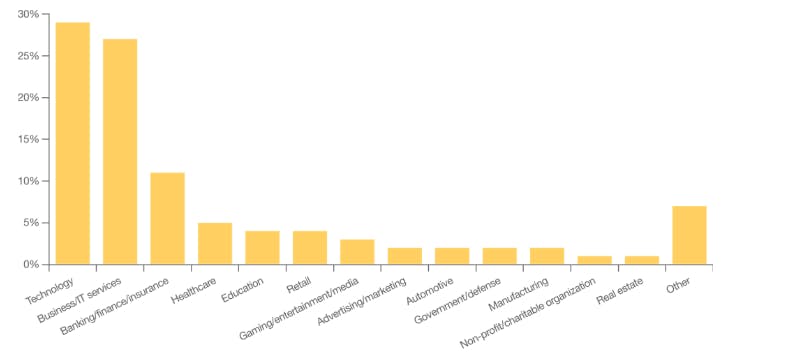
Source: Postman
Postman attributes the growth of its global user community to a construct it calls the “API network effect.” In observing companies that leveraged an API-first approach, the company learned that many of them follow a typical cycle of Postman adoption.
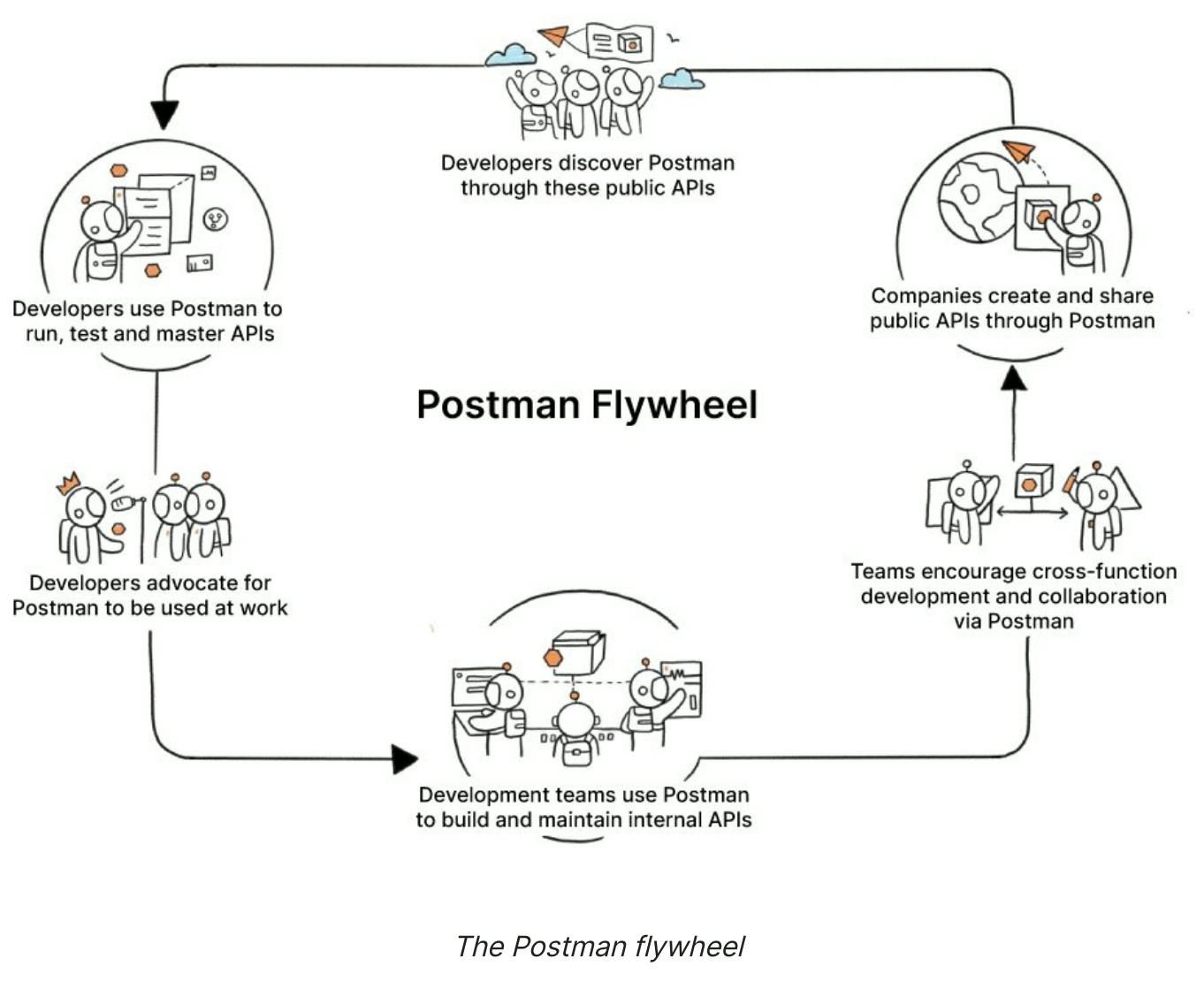
Source: Postman
Such a flywheel, if Postman is correct about it, could benefit from the growth of low-code and no-code API developers. In 2023, 53% of Postman users were classified as non-devs, continuing a growing trend from previous years.
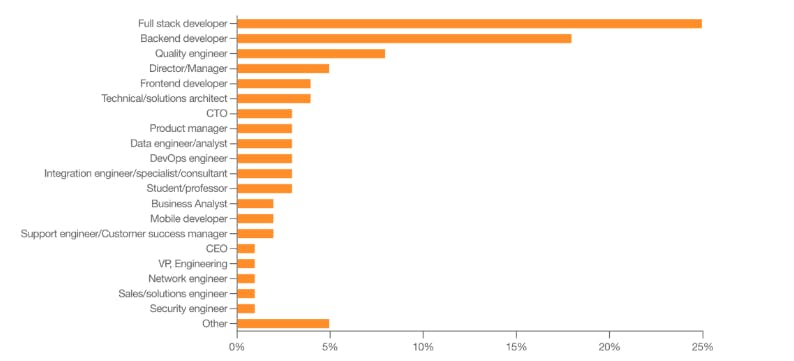
Source: Postman
Market Size
In 2017, the potential economic value of integrating APIs across different sectors was estimated at roughly $1 trillion. This estimate has likely only increased since then. The demand for API lifecycle management tools is increasing, with individuals and businesses looking for solutions to build and manage APIs effectively. The global API management market size was estimated at $5.1 billion in 2022 and is projected to grow to $94.3 billion within a decade.
One key growth driver is the rising demand for increasingly connected services, applications, and clouds. Additionally, with increased accessibility and transparency of APIs, members outside of traditionally arcane IT departments can now tinker with APIs. Finally, many large, monolithic tech architectures have paved the way for significant growth opportunities within API management as they decompose into microservices.
Postman’s 2023 State of the API report found that users have logged into Postman from 50 different countries representing 235 distinct geographic areas, including Antarctica. Across all geographies, users made nearly 1.3 billionAPI queries, 60% of which came from just 10 countries. With growing software opportunities across a wide range of industries, the API management market is evolving rapidly to meet global demand.
Competition
Cloud Providers
Google Apigee API Management: Apigee Edge, now part of Google Cloud, offers an API management platform that enables organizations to design, secure, analyze, and monetize their APIs. It provides features like API lifecycle management, security controls, and analytics dashboards. Apigee Edge supports hybrid and multi-cloud deployments, allowing customers to manage APIs across various environments. Apigee Edge differentiates itself by its strong integration with Google Cloud products and its ability to manage API calls to Google's serverless offerings. Prior to being acquired by Alphabet in 2016 for $625 million, Apigee had raised approximately $150 million in funding.
Microsoft Azure API Management: Azure API Management is a service offered by Microsoft as part of its Azure Integration Services. It provides a platform for designing, managing, and securing APIs, primarily targeted at Microsoft Azure cloud customers. Azure API Management is available in multiple pricing tiers and supports both cloud and hybrid deployments. Azure API Management differentiates itself through its tight integration with the Azure ecosystem, allowing integration with other Azure services and infrastructure. Microsoft’s cloud services division drives) significant financial results for the company.
Private Companies
Insomnia: Insomnia is an API management tool that helps developers design, debug, test, and manage APIs. Insomnia combines an easy-to-use interface with advanced functionality like authentication helpers, code generation, and environment variables. Insomnia is an open-source tool that is available for download. Insomnia was acquired by Kongin October 2019 for an undisclosed amount.
RapidAPI: RapidAPI is an API marketplace and management platform that provides developers with a unified interface to discover, test, and integrate various APIs. The platform simplifies the integration process by offering a centralized hub for accessing multiple APIs from different providers. RapidAPI differentiates itself as a marketplace that connects API providers and consumers, providing a wide range of APIs for developers to explore and integrate into their applications. RapidAPI has raised a total of $273 million in funding. In March 2022, the company raised a $150 million Series D at a $1 billion valuation led by SoftBank Vision Fund 2. Other notable investors include M12 (Microsoft's venture fund), Andreessen Horowitz, and Green Bay Ventures.
WSO2 API Manager: WSO2 API Manager is an open-source API management solution that combines integration and API management capabilities. It allows organizations to expose integrations as managed APIs across various architectures, including cloud, on-premises, container-native, and hybrid environments. WSO2 API Manager provides options for Micro Integrator and Streaming Integrator as stand-alone solutions, and it also includes WSO2 Identity Server for identity management. Specific funding details for WSO2 API Manager are not available as it is part of the broader WSO2 platform. WSO2 has raised a total funding of $134 million from investors such as Goldman Sachs.
In addition, Postman’s API testing capabilities have a number of other competitors, including SoapUI, Swagger, ReadyAPI, HTTpie, TestSigma, and JMeter among others.
Adjacent Players
Amazon API Gateway: Amazon API Gateway is a fully managed service for developers to publish, maintain, monitor, secure, and operate APIs at scale. Amazon API Gateway provides a range of features, including support for RESTful APIs and WebSocket APIs, private integrations with Amazon Elastic Load Balancer (ELB) and Amazon Cloud Map, resiliency, easy API creation, and deployment, and built-in monitoring and analytics. Unlike Postman, which is an API management platform that enables workflow management and full lifecycle tools on top of being an API gateway, Amazon’s API Gateway primarily provides features specific to deployment, as opposed to testing. Amazon API Gateway distinguishes itself from other competitors by its tight integration with the AWS ecosystem, allowing developers to leverage a wide range of cloud services and infrastructure. AWS is a significant part of Amazon's business, generating 14% of the company's revenue.
Kong: Kong's API Gateway is a popular open-source tool designed to manage, secure, and orchestrate microservices and APIs. Kong facilitates the creation, publishing, management, and monitoring of APIs and microservices. The platform is built to enable both scalability and security for API traffic. Similar to Amazon’s API Gateway, Kong’s primary product is focused on the deployment of APIs rather than development. Kong’s 2019 acquisition of Insomnia moved the platform further into a broad API lifecycle management tool. Kong has raised a total of $169 million in funding over 6 rounds. In February 2021, the company raised a $100 million Series D round led by Tiger Global, with participation from new investor Goldman Sachs as well as existing investors Index Ventures, CRV, Andreessen Horowitz, and GGV Capital.
Business Model
Postman's business model is primarily based on a freemium model, where the basic service is free to use, but paid plans are available for organizations that require additional features and functionality. Postman offers three different paid plans: Team, Business, and Enterprise, with prices starting at $168 annually. The free plan has limited features, while the paid plans offer additional features such as collaboration, version control, and advanced monitoring. Postman's paid plans are designed for teams of any size, from small startups to large enterprises.
The plans offer different levels of support, with the Enterprise plan providing the highest level of support, including access to support specialists and a one-day response time. Customers on the Enterprise plan are also assigned a dedicated Customer Success Manager. Postman also offers add-ons such as monitoring and mock server add-ons that can be selected when purchasing a plan. Customers on the Postman Basic and Professional plans can add licenses at any point in the subscription.
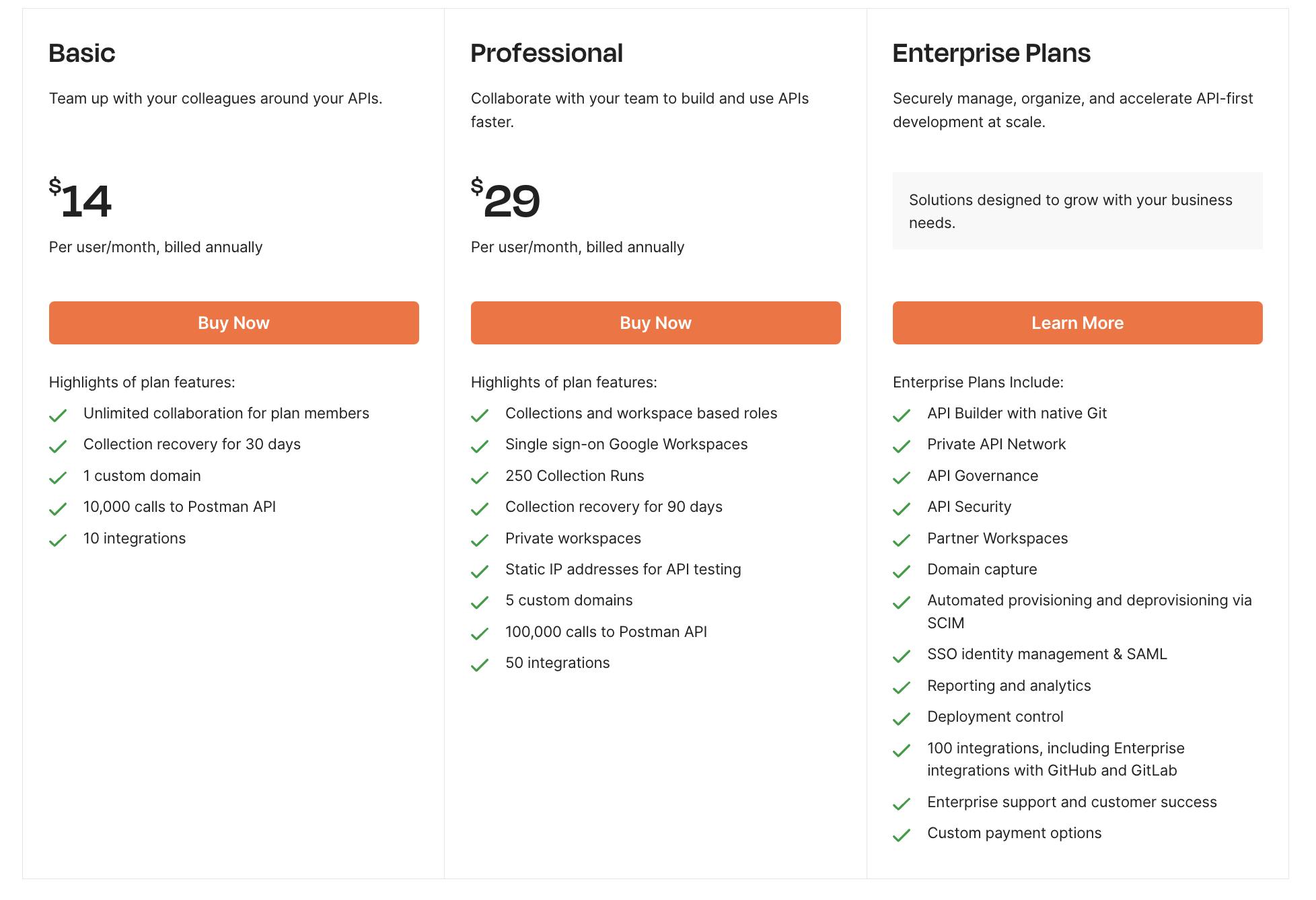
Source: Postman
Traction
Postman has seen significant traction in the market. It claims to be the largest public API hub in the world, and as of February 2023 hosted over 122K public workspaces. Postman also reported that its platform was used by 25 million users and 500K organizations worldwide. Since 2022, users have consistently created more than 1 billion requests annually, calling on more than 75K APIs on the Public API Network and organizing more than 35K collections of API requests in over 20K workspaces.
When Postman raised a Series D in August 2021, the company was valued at $5.6 billion. While the company declined to disclose revenue information, at the time it was shared that the round had valued the company at over 100x revenue. That would imply the company was at ~$56 million in revenue in August 2021. Since then, unverified sources have indicated that Postman is at ~$171 million in revenue as of 2023.
Valuation
Since its founding in 2014, Postman has raised $433 million. In August 2021, Postman raised a $225 million Series D at a $5.6 billion valuation. At the time, an investor in the company indicated that valuation was over 100x revenue. The round was led by Insight Partners, with participation from new investors Coatue, Battery Ventures, and Bond, as well as existing investors CRV and Nexus Venture Partners. At the time, Postman announced that it planned to use the funds to expand its sales, marketing, product, and engineering teams, as well as provide API-related education programs and support open-source initiatives.
Other developer-focused tools, like GitLab, Atlassian, HashiCorp, and JFrog, hit 2021 highs of 60-100x revenue in the public markets. However, over the course of 2022 and 2023, those multiples have collapsed to ~5-12x revenue. Assuming Postman’s unverified revenue estimate of $171 million in 2023 is accurate, that would represent a potential valuation range of $855 million to $2 billion.
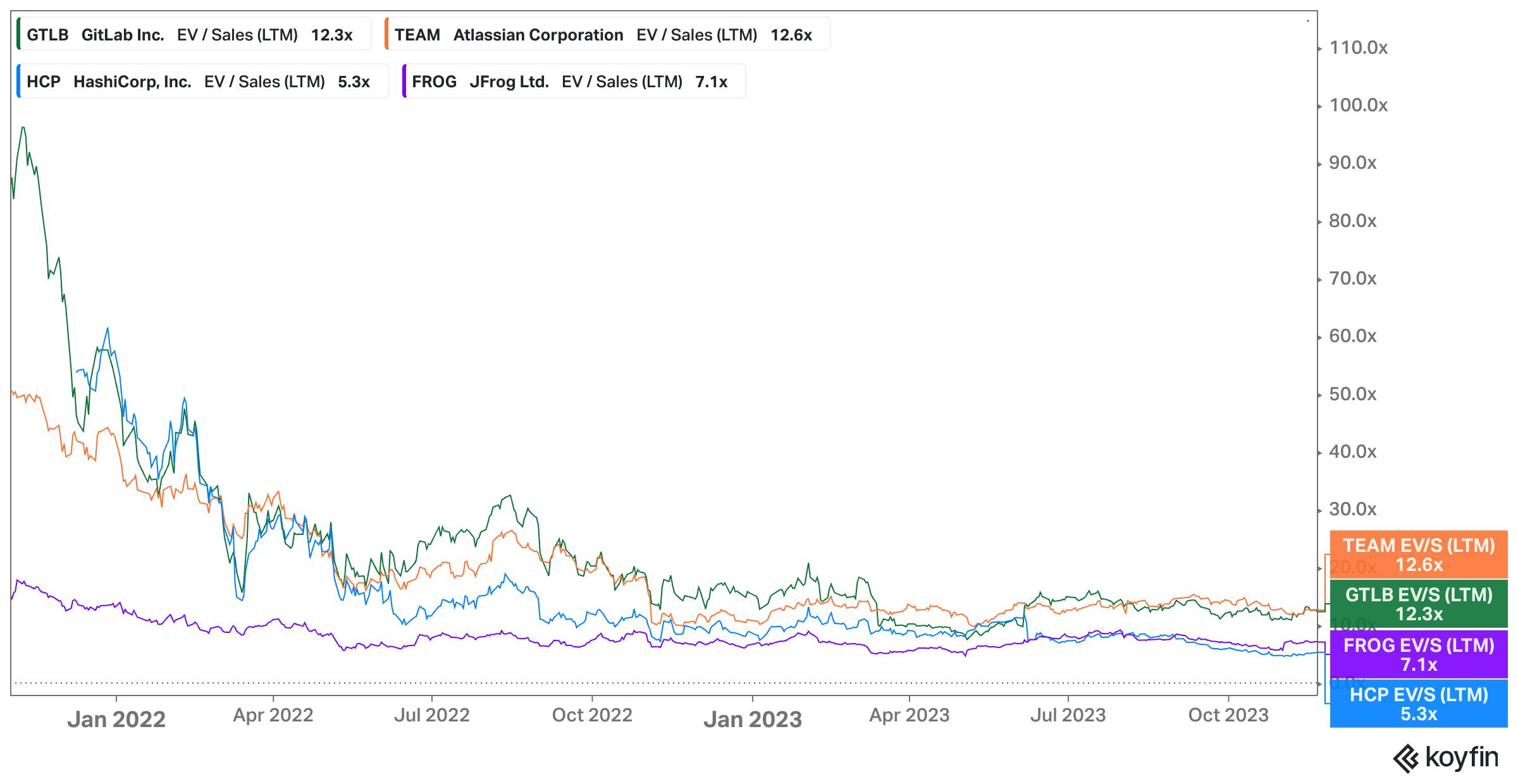
Source: Koyfin
Key Opportunities
No-Code / Low-Code Customer Segment
Since as early as 2021, over half of Postman’s users report being in less technical roles, ranging from product management to sales. In particular, Postman has spearheaded the no-code/low-code wave within API management through its announcement of Postman Flows in November 2022, its no-code tool for non-developers. Postman Flows allows users to create a chain of requests in a visual workspace without writing any code. This tool provides a collaborative, graphical interface for building API-driven applications and workflows. Postman Flows integrates with the Postman API Network to access publicly available APIs. Postman is also participating in Low-Code/No-Code Dev Day, a one-day event designed to help organizations understand the use of low-code.
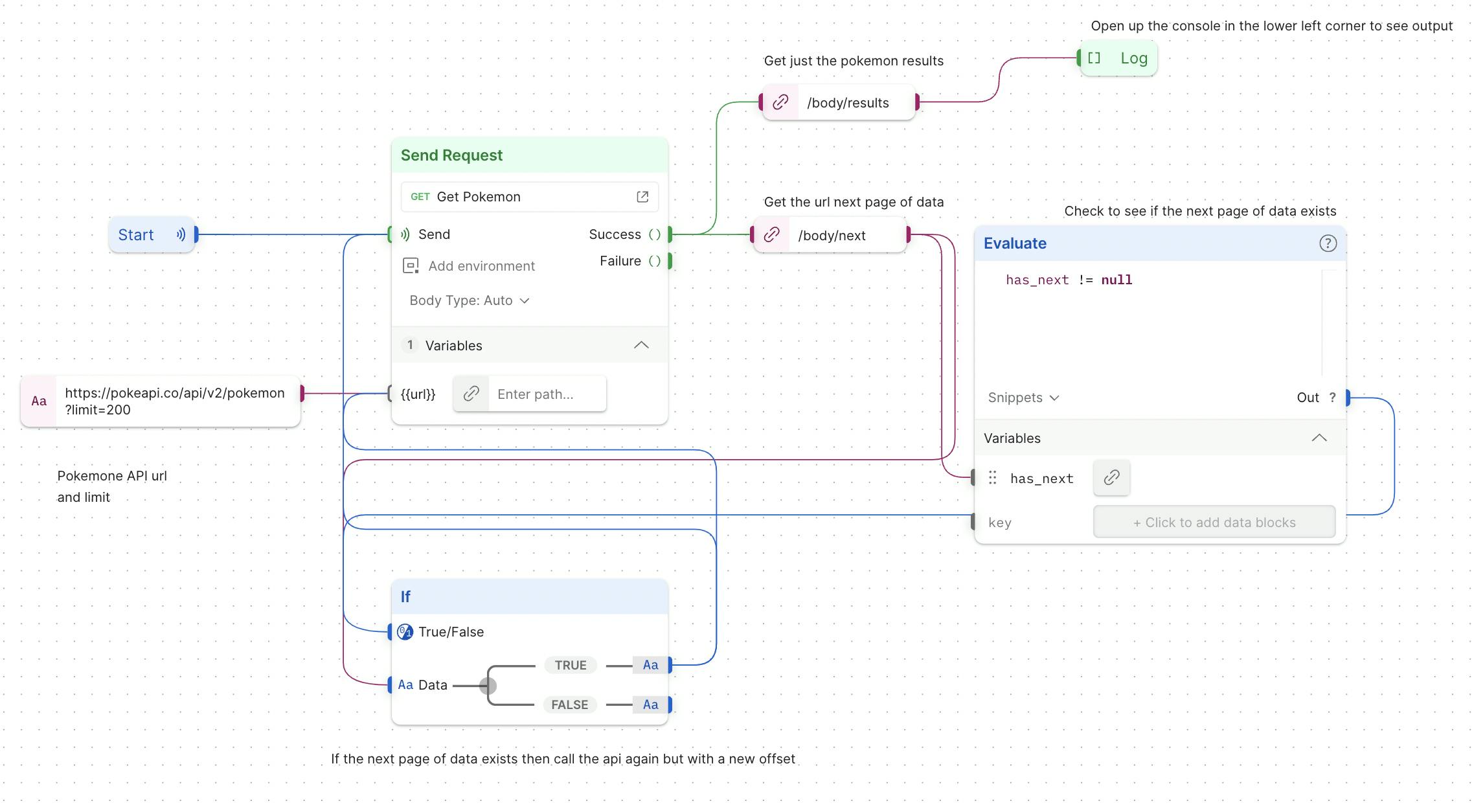
Source: Postman
By developing and releasing Postman Flows, Postman is providing a platform for API development that caters to users who prefer a no-code/low-code solution. At the end of 2023, 53% of Postman users were non-developers. While the majority of developer tools are used only by software engineers, Postman caters to a much larger addressable market.
AI-Powered API Production & Testing
As one of the world’s largest collection of APIs, Postman has access to a massive amount of API-related data. This data can be leveraged to fine-tune specific code-assist models and improve the performance of AI-driven features within Postman's platform. In May 2023, Postman released Postbot, its AI assistant for API workflows. In short, Postbot significantly boosts the productivity of devs using Postman’s platform. Postbot’s ability to help developers debug and understand APIs, write tests faster, and make sense of large quantities of data is supercharged by Postman’s extensive data on how its customers manage lifecycle API development. As of July 2023, Postbot was in Open Beta, available for Basic & Pro plans as an add-on at $9/month. In November 2023, Postman announced that Postbot was also being used to generate API documentation.
Key Risks
Security and Privacy Concerns
As of Q1 2023, 94% of organizations reported security problems in the production of APIs. Furthermore, in 2021, Gartner projected that API abuses would be the most frequent attack vector responsible for data breaches. Postman has implemented several measures to address these security concerns, including role-based access control, two-factor authentication, and infrastructure security. Postman also provides a set of default security rules based on the OWASP Top 10 for APIs to help users avoid exploitable security vulnerabilities. By following best practices for API security and using Postman's security features, users can help mitigate these security concerns and protect their APIs and data.
Adaptation to New API Standards
As new technologies emerge and architectural styles shift, it becomes crucial for API management solutions like Postman to keep up with these changes and adapt accordingly. The evolving technology landscape brings new communication protocols, data formats, and architectural patterns. According to a customer of Postman, developers frequently shift tools to best serve their preferences and use cases. Postman is known for its REST capabilities but needs to adapt to new trends in the API back-end space to keep up with the latest industry standards and emerging technologies. In one customer interview, it was noted that Postman did not support GraphQL early on, which made developers at the company start using the GraphiQL solution instead.
Competitive Pressures
Postman faces competition from large tech companies and open-source projects alike. Open-source projects like Insomnia offer similar services and have been gaining traction. On the other hand, major tech companies like Google Apigee and Microsoft Azure also offer API management tools that can leverage their vast resources and customer bases. Postman needs to continue innovating at a fast pace to maintain or grow its market share. This is especially true as a large number of developers use the free version of Postman during the testing and exploration phase of a project. Given the large number of alternatives in the market, Postman may risk churning customers if it eliminates the free version or raises prices.
Summary
Postman operates in the API management market, offering a comprehensive platform that simplifies the API lifecycle and streamlines collaboration for developers. Its product suite includes features such as an API repository, a comprehensive toolset, governance capabilities, low-code workflows, API testing features, and integration with various technologies. Postman has gained significant traction in the market by providing developers with a user-friendly platform that enhances productivity and efficiency in API development. The company has become a popular choice among developers and teams due to its robust features, comprehensive documentation, and active community support. As the API landscape continues to evolve, Postman must stay updated with new standards, technologies, and customer expectations to remain competitive and provide value to its users.





